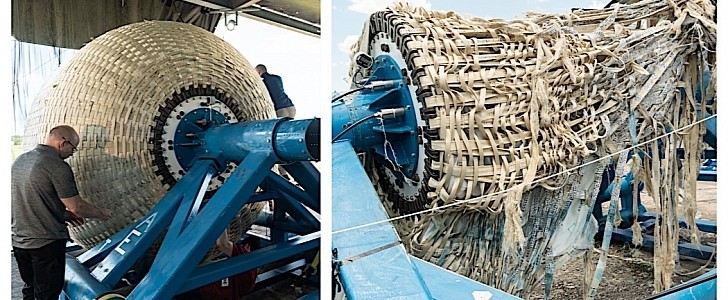Of all the technologies currently being developed for our species’ future space exploration efforts, the Large Inflatable Flexible Environment must be one of the craziest. Being developed by Sierra Space, the so-called LIFE could forever change the way humans see orbital real estate needs.
LIFE is, in essence, a space habitat. What sets it apart from current designs is the fact it’s inflatable, meaning it can be launched from Earth in a diminished size and grow to its full dimensions once at the destination.
The module is made of a fiber called Vectran (the same used in the spacesuits of the Apollo program, EVA activities of later dates, and even on the ISS), but also nylon and urethane, tied together by a woven structural restraint layer, “strong enough to withstand the internal pressure required for the crew to live and work.”
As it is envisioned now, LIFE can grow to a maximum diameter size of 27 feet (8.2 meters) and provides a pressurized volume of 300 cubic meters (10,594 cubic feet), a third of the volume available on the ISS.
This week, Sierra Space said it successfully performed a burst pressure test on a one-third scale LIFE module. Although designed to burst at 182.4 psi (safety requirement), LIFE did not do that until the gauge reached 192 psi.
Later in the year, Sierra Space plans another pressure test, followed in the coming years by others, targeting different attributes of the habitat. Once cleared for deployment, LIFE will be used on Jeff Bezos’ upcoming Orbital Reef, but could also become a pillar of other future space stations, but also human bases on other worlds.
“The product has many applications in low-Earth orbit and for deep-space and surface habitation on the moon and Mars," said in a statement Sierra Space Space Destinations general manager, Neeraj Gupta.
"LIFE will revolutionize humans’ ability to commercialize and explore space and we could not be prouder to achieve this important milestone. Sierra Space is leading the development of advanced inflatable habitat systems and continues to be the leader in softgoods inflatable systems and architectures.”
The module is made of a fiber called Vectran (the same used in the spacesuits of the Apollo program, EVA activities of later dates, and even on the ISS), but also nylon and urethane, tied together by a woven structural restraint layer, “strong enough to withstand the internal pressure required for the crew to live and work.”
As it is envisioned now, LIFE can grow to a maximum diameter size of 27 feet (8.2 meters) and provides a pressurized volume of 300 cubic meters (10,594 cubic feet), a third of the volume available on the ISS.
This week, Sierra Space said it successfully performed a burst pressure test on a one-third scale LIFE module. Although designed to burst at 182.4 psi (safety requirement), LIFE did not do that until the gauge reached 192 psi.
Later in the year, Sierra Space plans another pressure test, followed in the coming years by others, targeting different attributes of the habitat. Once cleared for deployment, LIFE will be used on Jeff Bezos’ upcoming Orbital Reef, but could also become a pillar of other future space stations, but also human bases on other worlds.
“The product has many applications in low-Earth orbit and for deep-space and surface habitation on the moon and Mars," said in a statement Sierra Space Space Destinations general manager, Neeraj Gupta.
"LIFE will revolutionize humans’ ability to commercialize and explore space and we could not be prouder to achieve this important milestone. Sierra Space is leading the development of advanced inflatable habitat systems and continues to be the leader in softgoods inflatable systems and architectures.”



















